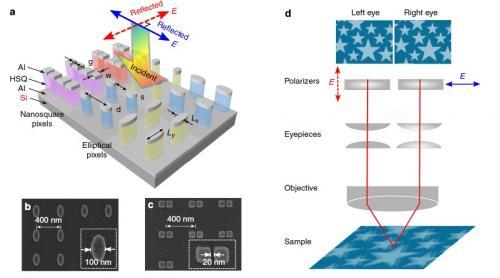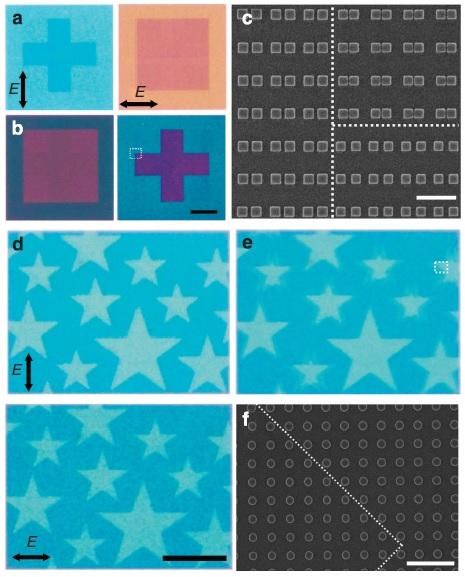 Researchers have been working on the area of color 3D printing — with stereoscopic microprints that create the impression of depth and solidity. By encoding two images in the same area using aluminum as material, the process is one that if commercialized for production could be affordable, highly functional, and offer the user a vast array of options for:
Researchers have been working on the area of color 3D printing — with stereoscopic microprints that create the impression of depth and solidity. By encoding two images in the same area using aluminum as material, the process is one that if commercialized for production could be affordable, highly functional, and offer the user a vast array of options for:
- Color displays
- Data storage
- Anti-counterfeiting technology
The trick is in coding two sets of information regarding color — in a single pixel — which can distribute either color depending on the angle you are looking at it from. If one is looking at the print from both polarizations, both colors can be seen. This technique can cause what is a stereoscopic, 3D image when viewing of two slightly displaced images at the same time.
“We have created possibly the smallest-ever stereoscopic images using pixels formed from plasmonic nanostructures,” said Professor Joel K.W. Yang. “Such stereoscopic images do not require the viewer to don special glasses, but instead, the depth perception and 3D effect is created simply by viewing the print through an optical microscope coupled with polarizers.”
Professor Joel K.W. Yang, at A*STAR (the Agency for Science, Technology and Research) in Singapore, the National University of Singapore, and the Singapore University of Technology and Design, have published a paper on the new technique for realizing 3D full-color stereoscopic prints in a recent issue of Nature Communications dealing with the issue of ‘surface plasmon resonance,’ regarding, simply, how nanostructures scatter wavelengths of light.
Researchers are able to play with these structures, light, and images depending on their shapes, which affect the polarization and resonance of the nanostructure. They also noted that with other shapes, they could make pixels that contain even more than two images.
When circular, the resonance is independent of polarization. When in the form of an ellipse or rectangle, resonance depends on the light polarization. Consequently, researchers were able to make various colors depending on polarization.
“One can envision application of these prints to high-density optical information encoding or holography,” Yang said. “3D security elements that are difficult to replicate, and which offer different levels of authentication, could also be generated for anti-counterfeiting and anti-forgery technologies.”
The researchers used many tiny pieces of aluminum to create the nanopixels and experiment with shapes and images and the varying degrees of depth perception and color. Using elliptical pixels and nanosquare dimers, the researchers discovered that the two had a wide range of variation of colors and depending on polarization it was different for each, as the elliptical pixels had a broad range of color, while the others had ‘lower levels of cross-talk, minimizing unwanted mixing of colors.’
As an example of what their nanopixels could do, the researchers used stars as a 2D design. They overlaid displaced images in the same view and then added different polarizers to a microscope viewing area, which displayed the images in — you got it — 3D. The researchers plan to try and market their stereoscopic microprints.
“Moving forward, there is much interest in developing techniques for creating such prints with significantly lower cost and higher throughput, both of which are imperative for this technology to be implementable at an industrial level,” Yang said.
Have you ever worked with stereoscopic images? What do you think of the research work being done here? Tell us about it in the Stereoscopic 3D Microprints forum at 3DPB.com.

(Left) Elliptical and coupled nanosquare pixels scatter different wavelengths of light depending on polarization. (Right) The stereomicroscope setup uses different polarizers on each eyepiece to image two superposed microprints which contain pixels that present two laterally displaced images to the left and right eyes of a viewer, resulting in depth perception. Credit: Xiao Ming Goh, et al. ©2014 Macmillan Publishers Limited
Subscribe to Our Email Newsletter
Stay up-to-date on all the latest news from the 3D printing industry and receive information and offers from third party vendors.
You May Also Like
Precision at the Microscale: UK Researchers Advance Medical Devices with BMF’s 3D Printing Tech
University of Nottingham researchers are using Boston Micro Fabrication‘s (BMF) 3D printing technology to develop medical devices that improve compatibility with human tissue. Funded by a UK grant, this project...
3D Printing Webinar and Event Roundup: April 21, 2024
It’s another busy week of webinars and events, starting with Hannover Messe in Germany and continuing with Metalcasting Congress, Chinaplas, TechBlick’s Innovation Festival, and more. Stratasys continues its advanced training...
3D Printing Webinar and Event Roundup: March 17, 2024
It’s another busy week of webinars and events, including SALMED 2024 and AM Forum in Berlin. Stratasys continues its in-person training and is offering two webinars, ASTM is holding a...
3D Printed Micro Antenna is 15% Smaller and 6X Lighter
Horizon Microtechnologies has achieved success in creating a high-frequency D-Band horn antenna through micro 3D printing. However, this achievement did not rely solely on 3D printing; it involved a combination...






























